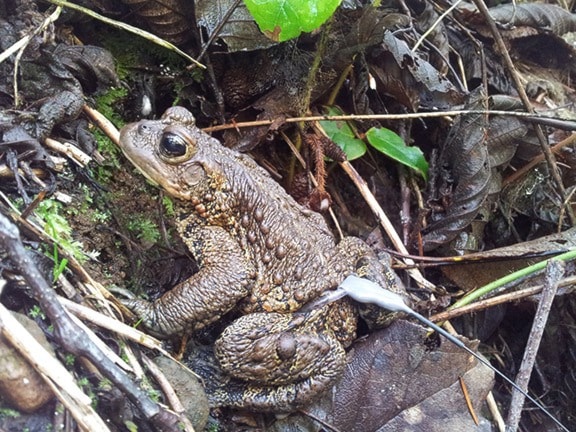Residents of Sahtlam and the surrounding area shouldn’t be surprised if they come across work crews wearing high-visibility vests walking and/or driving through their neighbourhood in the coming weeks.
The crews are part of an ongoing study of the populations in the area of western toads, whose numbers have drastically declined on Vancouver Island in recent years.
This year’s research begins in September and ends in February.
Elke Wind, an amphibian biologist and consultant who is a spokeswoman for the research project, said researchers are looking for the public’s assistance to watch for the toads on their properties and in their neighbourhoods.
She said people are being asked to place any of the western toads they come across in a tall bucket with a lid and email duncantoads@gmail.com
Wind said researchers will then collect the toads and place location transmitters on them so they can be monitored when they are released.
The toads can be up to 12 centimetres long and either light to dark brown or olive-coloured, often with a cream-coloured stripe running down their back.
They also have wart-like bumps on their skin.
“About 50 per cent of the toads we fitted with transmitters last year were found by members of the public, so we really rely on people to help us with this research,” she said. “We’ve already completed a big mail-out to the community providing people with information on the project and what they can do to help.”
On the south coast of B.C., where rural and urban development has been extensive, the breeding populations of western toads, which are listed as a species of special concern by both the province and Ottawa, are relatively rare, patchily distributed and believed to be in decline.
In fact, amphibian populations have declined in many parts of the world because frogs, toads and salamanders are sensitive to climatic conditions and pollution, so their populations act like a “canary in a coal mine”, reflecting the state of the environment.
The overall goal of this multi-year project, which is now in its last year, is to identify important western toad habitats on eastern Vancouver Island in order to protect them and to determine what the toads need in their habitats for their annual hibernation cycle.
Of the 23 toads fitted with transmitters in the Sahtlam area last fall, researchers tracked 13 toads to 12 confirmed hibernation sites in the area.
Wind said the group is hosting a public presentation at the Sahtlam Community Hall on Sept. 20.
It begins at 7 p.m. with a talk and question period followed by a demonstration of toad-handling procedures, how a transmitter is put on, and letting people try their hand at finding a hidden transmitter using a receiver.
